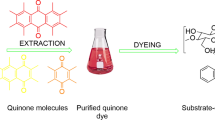Abstract
Chromatic characteristics and their relationships with copigmentation and phenolic composition were studied in 160 bottled red wines. Free anthocyanins, copigmented anthocyanins and polymeric pigments contributing to color were calculated according to Boulton protocol and related to main changes produced in wine visible spectra after destroying any copigmented anthocyanins effect. Color differences between copigmented and non copigmented wines were quantified and related with ageing, cultivar and phenolic profile. Phenomenon of co-pigmentation visually increases the colour at 420, 520 and 620 nm for most of wines. Copigmented wines showed a mean value of 8.26 CIELab units higher than non copigmented (ΔEab(c-nc)), being this shift deeper for young wines than for aged wines. Copigmentation mostly changed hue and decreased L, a* and b* values therefore resulted into purplish and darker wine. Visual variations in color caused by copigmentation was related to particularly anthocyanins and copigments (mostly flavonols and hydroxycinnamic acids).


Similar content being viewed by others
References
Baiano A, Terracone C (2011) Varietal differences among the phenolic profiles and antioxidant activities of seven table grape cultivars grown in the south of Italy base on chemometrics. J Agric Food Chem 59:9815–9826
Boulton RB (1996) A method for the assessment of copigmentation in red wines. Am J Enol Vitic 47:346
Boulton RB (2001) The copigmentation of anthocyanins and its role in the color of red wine: a critical review. Am J Enol Vitic 52:67–87
Brouillard R, Dangles O (1994) Anthocyanins molecular interactions: the first step in the formation of new pigments during wine aging. Food Chem 51:365–371
Brouillard R, Delaporte B, Dubois JE (1978) Chemistry of anthocyanin pigments. 3. Relaxation amplitudes in pH jump experiments. J Am Chem Soc 100:6200–6205
Cayla L, Cottereau R, Renard R (2002) Estimation de la maturité phénolique des raisins rouges para la méthode I.T.V. standard. Rev Fr Oenol 193:10–16
Darias-Martín J, Martín-Luis B, Carrillo-López M, Lamuela-Raventós R, Díaz-Romero C, Boulton R (2002) Effect of caffeic acid on the color of red wine. J Agric Food Chem 50:2062–2067
Darias-Martín J, Carrillo-López M, Echavarri-Granado J, Díaz-Romero C (2007) The magnitude of copigmentation in the color of aged red wines made in the Canary Islands. Eur Food Res Technol 224:643–648
Francia-Aricha E, Guerra MT, Rivas-Gonzalo JC, Santos-Buelga C (1997) New anthocyane pigments formed after condensation with flavanols. J Agric Food Chem 45:2262–2266
Furtado P, Figuereido P, Chaves H, Pina F (1993) Photochemical and thermal degradation of anthocyanidins. J Photochem Photobiol A 75:113–118
Garcia-Marino J, Escudero-Gilete ML, Heredia FJ, Escribano-Bailón MT, Rivas-Gonzalo JC (2013) Color-copigmentation study by tristimulus colorimetry (CIELab) in red wines obtained from Tempranillo and Graciano cultivars. Food Res Int 151:123–131
Glories Y (1984) La couleur des vins rouges, 2ème partie. Mesure, origine et interprétation. Connaiss Vigne Vin 18:253–271
Gonnet JF (1999) Color effects of co-pigmentation of anthocyanins revisited – 2. A colorimetric look at the solutions of cyanin co-pigmented by rutin using the CIELab scale. Food Chem 66:387–394
He F, Liang NN, Mu L, Pan QH, Wang J, Reeves MJ, Duan CQ (2012) Anthocyanins and their variation in red wines II. Anthocyanin derived pigments and their color evolution. Molecules 17:1483–1519
Heras-Roger J, Pomposo-Medina M, Díaz-Romero C, Darias-Martín J (2014) Copigmentation, color and antioxidant activity of single cultivar red wines. Eur Food Res Technol 239:13–19
Hermosín-Gutiérrez I, Sánchez-Palomo L, Vicario-Espinosa A (2005) Phenolic composition and magnitude of copigmentation in young and shortly aged red wines made from the cultivars, Cabernet Sauvignon, Cencibel and Syrah. Food Chem 92:269–283
Ibern-Gómez M, Andrés-Lacueva C, Lamuela-Raventós RM, Waterhouse AL (2002) Rapid HPLC analysis of phenolic compounds in red wines. Am J Enol Vitic 53:3
Kontoudakis N, Gonzalez E, Gil M, Esteruelas M, Fort F, Canals JM, Zamora F (2011) Influence of wine pH on changes in color and polyphenol composition induced by micro-oxygenation. J Agric Food Chem 59:1974–1984
Lamuela-Raventós RM, Waterhouse AL (1994) A direct HPLC separation of wine phenolics. Am J Enol Vitic 45:1
Martínez JA, Melgosa M, Pérez MM, Hita E, Negueruela A (2001) Note. Visual and instrumental color evaluation in red wines. Food Sci Technol Int 5:439–444
Mazza G, Brouillard R (1990) The mechanism of co-pigmentation of anthocyanins in aqueous solutions. Phytochemistry 29:1097–1102
OIV (2014) Determination of chromatic characteristics according to CIELab in compendium of international methods of wine and must analysis, 11th edn. OIV, Paris, France
Parpinello GP, Versari A, Chinnici F, Galassi S (2009) A Relationship among sensory descriptors, consumer preference and color parameters of Italian Novello red wines. Food Res Int 42:1389–1395
Pérez Caballero V, Ayala F, Echávarri JF, Negueruela A (2003) Proposal for a new standard OIV method for determination of chromatic characteristics of wine. Am J Enol Vitic 54:59–62
Torskangerpoll K, Andersen OM (2005) Color stability of anthocyanins in aqueous solutions at various pH values. Food Chem 89:427–440
Vivar-Quintana AM, Santos-Buelga C, Rivas-Gonzalo JC (2002) Anthocyanin-derived pigments and color of red wines. Anal Chim Acta 458:147–155
Author information
Authors and Affiliations
Corresponding author
Additional information
Highlights
• Copigmentation decreases hue, hab, and L* CIELab components but increases color intensity
• Visual consequences of copigmentation would be noticeable even by a non-trained person.
• Blended wines show higher copigmentation values than single-cultivar ones.
• Copigmentation visual effects are significantly correlated with the concentration of most flavonols.
• Blue color component seems to be particularly related to wine ageing.
Rights and permissions
About this article
Cite this article
Heras-Roger, J., Alonso-Alonso, O., Gallo-Montesdeoca, A. et al. Influence of copigmentation and phenolic composition on wine color. J Food Sci Technol 53, 2540–2547 (2016). https://doi.org/10.1007/s13197-016-2210-3
Revised:
Accepted:
Published:
Issue Date:
DOI: https://doi.org/10.1007/s13197-016-2210-3




